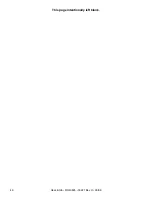
Heat & Glo • RHW-485 • 33221 Rev O • 08/06
31
10
10
Troubleshooting
Another appliance in
home also exhausting
air (furnace, fan,
dryer, etc.)?
Air register from
furnace near
fireplace?
Doors opening
and closing?
Window closed
for start-up?
Outside air
closed?
Overhead fan
operating?
Overhanging
tree?
Bird's nest
or leaves in
termination
cap?
Structural
changes in
chimney area?
Creosote buildup
in flue?
Damper closed?
Stron
g w
in
ds
a
ro
un
d c
himney
term
ina
tio
n?
Unsealed
can lights?
Figure 10.1 Factory-built Fireplaces: Troubleshooting
This
fi
replace will operate correctly only if adequate ventila-
tion is provided to allow proper draft to the
fi
replace system.
Hearth & Home Technologies assumes no responsibility for
the improper performance of the
fi
replace system caused
by inadequate draft due to environmental conditions, down
drafts, tight sealing construction of the structure, or mechan-
ical exhausting devices which will create a negative air pres-
sure within the structure where the
fi
replace is located.
A. Understanding Vent Problems
If smoke spillage occurs from a
fi
replace opening when the
door is open and the proper chimney height,
fl
ue size, and
con
fi
guration requirements for the installation have been
met, there is either a leakage in the
fl
ue, a blockage in the
fl
ue, or some condition is in effect to draw smoke from the
fi
replace into the house. Understanding and differentiating
the conditions which can cause each of these kinds of spill-
age problems is essential to their solution.
• Flue
Leakage
Check for improperly connected
fl
ue joints or a damaged
fl
ue joint in the chimney system. Such leakage would
reduce draft (air would be drawn in through the leaks rather
than through the
fi
replace). The result might be dif
fi
cult
start-up and smoky
fi
res that might spill if other adverse
draft conditions accompany this problem.
• Flue
Blockage
The damper should be open.
















































